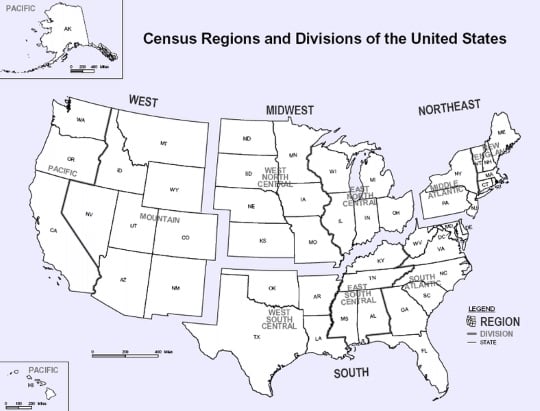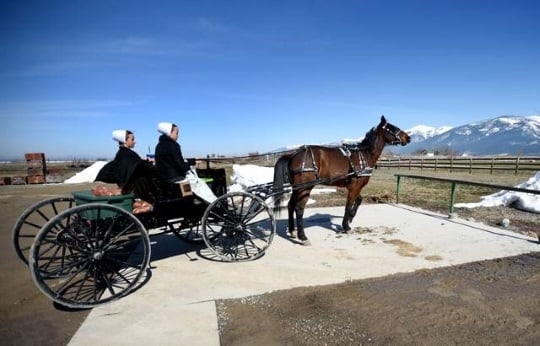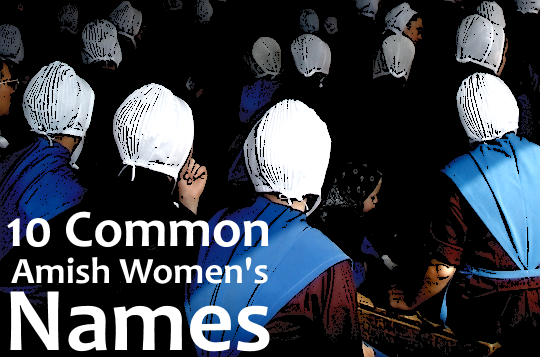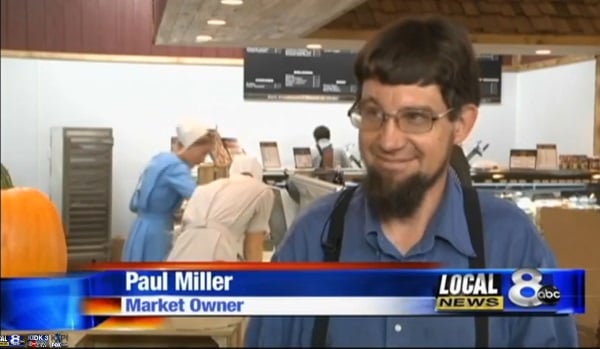The 4 Western States With An Amish Population (2018)
Following our look at the 12 Southern states with Amish communities, today we look to the traditionally least-populated-by-Amish region, the West.

As Steven Nolt describes in A History of the Amish, Amish arrived in America in two main waves, first settling primarily in Pennsylvania, and later in the Midwest.
Over their history on multiple occasions Amish have felt the pull of the West…but for various reasons, have never had a very large population there. Amish have tried settling states including California, Oregon, and Colorado.
Colorado is one of the handful of Western states that have an Amish population today, but California and most of the rest of the region’s 11 states do not.
Reasons such as climate and distance from other Amish communities discourage new settlement in the West. But recent years have seen a handful of new Western communities added to the Amish map.

Western States With Amish – 2018
The following four states have an Amish population, with numbers provided here sourced from the Young Center’s Amish Studies website. I’ve listed them in descending order of Amish population.

1. Montana (7 settlements; 780 Amish) – The Treasure State has the region’s longest-established Amish population, with Amish planting their proverbial flag at Rexford back in 1974. Sadly the Rexford settlement was ravaged by a late-summer wildfire last year.
The St. Ignatius settlement was featured here earlier this year for their Mission General Store. Amish in this community hold an annual benefit auction for their school, and have also supported the local ambulance service via an auction. The community at Rexford is the westernmost of all Amish settlements.
2. Colorado (3 settlements; 600 Amish) – This state has drawn some interest from Amish in recent years, with all of its communities founded since the turn of the century. Though the number of communities here has actually decreased from four in 2010 to the present three, two of those three are each two church districts in size (Monte Vista and Westcliffe).
If you watched the excellent PBS documentary The Amish, you may remember a notable scene in which Amish are visiting land in Custer County, Colorado (Westcliffe) in advance of settling there.
3. Wyoming (1 settlement; 105 Amish) – Amish settled in Crook County near the town of Hulett in 2011. Reportedly the Amish here originated from states including Iowa and Missouri.
A local realtor shares that the original settlers purchased a ranch which they then divided, and that Amish chose this northeastern corner of the state for its better growing climate. Hulett lies near the famous Devil’s Tower national monument.

4. Idaho – The latest Raber’s Almanac tells us that this community lies in Lehmi County with a mailing address of Salmon (the church district is named Salmon River) though this article describes them as being closer to Baker.
Another report looked at the Country Market in Baker, run by the Paul Miller family, who originated in Pennsylvania. Idaho had seen some Amish settlement in the past, with a group living around four years in the early 2000s at Bonner’s Ferry.
Future States?
Will Amish settle in other Western States? Which might be the most likely candidates?
If I had to take a guess, I’d say the next two candidates would be Washington and New Mexico – in part for their proximity to existing communities. Amish have in fact lived in both states before, with a previous settler describing his eastern Washington community as “paradise”.







It’s interesting to me to learn about how the Amish in particular feel the need to set up communities in areas far from other Amish communities. They are true pioneers. I am interested in learning how they fare in coming years. I find the whole idea of their moving West to be a modern day adventure of a people who are traditionally known to be “in the world but not OF the world”. It’s gotta be difficult.
Amish in the West
Good thoughts Alice Mary, I think the natural beauty of the West draws some Amish to want to live there…it’s not uncommon that Amish from the East and Midwest take trips West when they are adolescents and early 20s for sightseeing or hunting. No doubt some return with the idea of wanting to make a home in some of the beautiful locations they’ve visited.
One big challenge though is having enough other Amish people around or close enough, especially when children grow older and need to find potential spouses.
That was one of the reasons for the end of the Washington community I mentioned at the end of the post. Here’s what Vernon Yoder said in the article:
‘“It’s paradise here,” Yoder said. “It’s going to be hard to leave it. But it’s for our families’ sake. We’ve got to do it if we’re going to keep our family together. That’s one of the most important things in life.”
The main problem, he said, is that some of their children are growing up and need to find mates who share their religion and background. Those who are leaving are all part of Yoder’s immediate and extended family.’
http://www.spokesman.com/stories/2004/may/21/washington-amish-settlement-dwindles-as-four/
As to gauging the long-term survivability of a fledgling Amish community, I imagine someone could probably work out a formula giving odds of survival factoring in things like size of the community, age of members, and distance to other Amish.
I enjoyed reading this post about Amish in 4 Western States. I also enjoy reading reports in The Budget newspaper from scribes in each of the 4 states. There are lots of reports of hunting of wild game animals, as well as many reports of Amish visitors coming to visit from Midwest and Eastern states.
In a recent issue of The Budget, one of the Montana scribes reminisced about the beginning of the Amish in Montana in the Rexford settlement in the 1970’s. They stated that in the early years, three Amish men bought a 27,000 acre ranch and “That was pioneering in the real sense of the word…” and “From that beginning we have spread out in settlements all across the Northwest…”.
I agree with you, Erik, that I think the next Western state for Amish to again settle is Washington. Eastern Washington is not far from Western Montana.
Wow 27,000 acres, I don’t know how that fares size-wise as far as your typical ranch out West goes, but sounds like a huge amount of land. So I’d suppose later settlers probably have purchased land sectioned off from this original parcel.
Interesting you agree on Washington state, it reminded me of this post from a few years ago…I did not include Washington but maybe it would be a good time to do another one of these. None of my predictions (NH, ND, UT, AL, AK) have seen Amish settlements in the three years since: https://amishamerica.com/five-new-states-where-amish-may-settle/
Alaska Settlement
As a former Alaska resident who now lives in Iowa, I can tell you that Alaska has very little farm land as such but subsistence is definitely a way of life already for Alaskan natives.
Concerning though, is how completely isolated and VERY far away Alaska is from the lower 48. If families had concerns not being able to find suitable mates for their children in Eastern WA, it would completely deter moving to Alaska.
Good point Pam, and I’d agree. Alaska made my list of predictions in large part because a group of Amish had actually made a recent trip to scout for land there.
Amish have tried to settle some rather remote places in the past but the odds are usually stacked against them, and one of the main problems is what you mention concerning distance.
https://amishamerica.com/five-new-states-where-amish-may-settle/
The Montana settlement is particularly interesting to me since that state has traditionally been home to the Hutterites, another German-speaking Anabaptist denomination that nonetheless has a completely different manner of living. I developed my own fascination with their culture after meeting a group from one colony while on a vacation to western Montana many years ago. It doesn’t seem like the Rexford settlement is close by to any of the colonies, but nonetheless wonder if there has been any interaction among them.
Amish and Hutterite interaction
Roger a few years ago we had a series of posts here on Hutterite life by Linda Maendel, who belongs to a Hutterite colony in Manitoba. The question of Amish/Hutterite interaction came up at one point on a post on Amish in South Dakota; here’s what Linda wrote:
‘Amish/Hutterite Interaction
Yes, Amish and Hutterites do interact. I know Hutterites who have Amish pen pals and there has been some visiting as well. There are many Hutterite colonies in South Dakota, so it’s likely that there would be a colony or two in that county.’
Not about Montana specifically but hopefully that’s of interest. Here’s the original comment thread:
https://amishamerica.com/amish-in-south-dakota/#comment-75335
Very interesting! I had no idea there were Amish in Wyoming and Montana. Would be nice to visit those communities someday.
I also noticed that the Saint Ignatius community is on the Flathead Reservation. I am curious to know how well they get along with the local Native Americans.
I haven’t heard about that, but I’d also be curious to know about any interaction or business between the two groups.